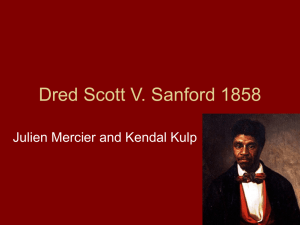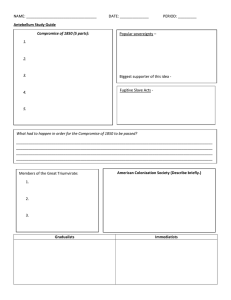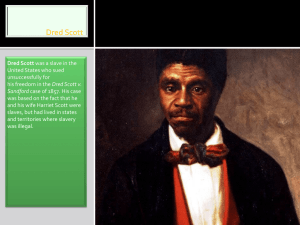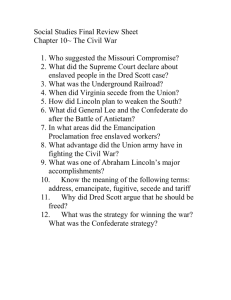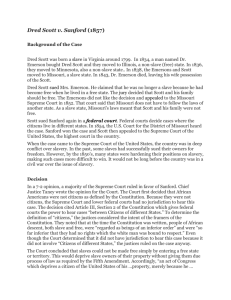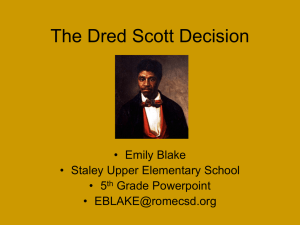View the three photos of monuments to Dred Scott below and
advertisement
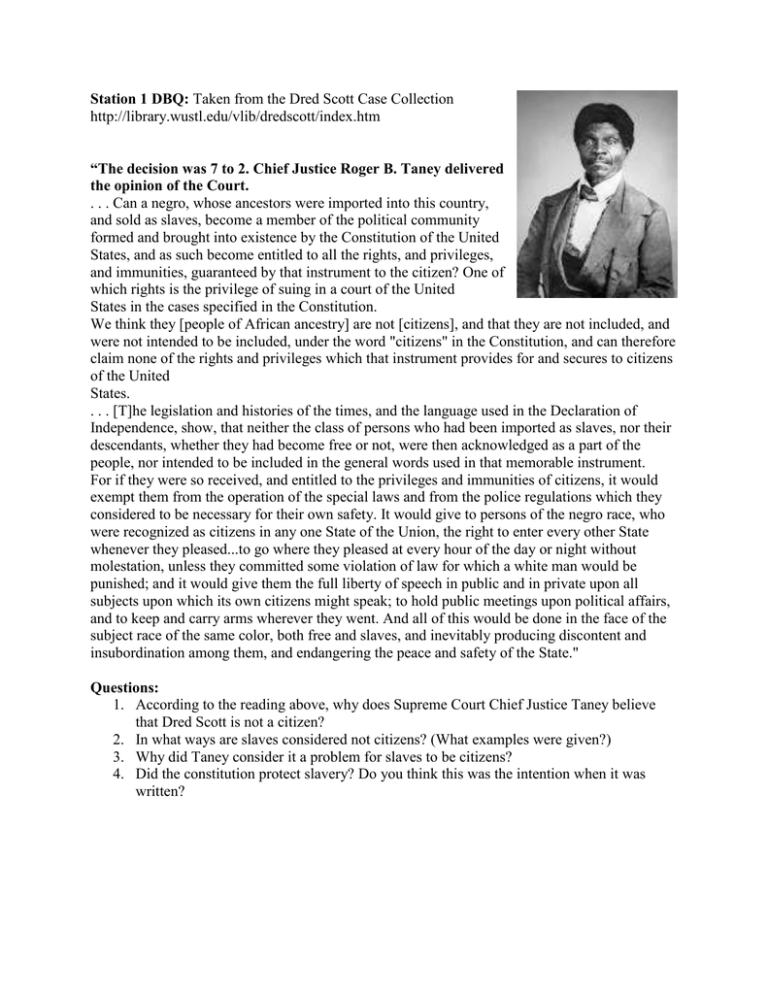
Station 1 DBQ: Taken from the Dred Scott Case Collection http://library.wustl.edu/vlib/dredscott/index.htm “The decision was 7 to 2. Chief Justice Roger B. Taney delivered the opinion of the Court. . . . Can a negro, whose ancestors were imported into this country, and sold as slaves, become a member of the political community formed and brought into existence by the Constitution of the United States, and as such become entitled to all the rights, and privileges, and immunities, guaranteed by that instrument to the citizen? One of which rights is the privilege of suing in a court of the United States in the cases specified in the Constitution. We think they [people of African ancestry] are not [citizens], and that they are not included, and were not intended to be included, under the word "citizens" in the Constitution, and can therefore claim none of the rights and privileges which that instrument provides for and secures to citizens of the United States. . . . [T]he legislation and histories of the times, and the language used in the Declaration of Independence, show, that neither the class of persons who had been imported as slaves, nor their descendants, whether they had become free or not, were then acknowledged as a part of the people, nor intended to be included in the general words used in that memorable instrument. For if they were so received, and entitled to the privileges and immunities of citizens, it would exempt them from the operation of the special laws and from the police regulations which they considered to be necessary for their own safety. It would give to persons of the negro race, who were recognized as citizens in any one State of the Union, the right to enter every other State whenever they pleased...to go where they pleased at every hour of the day or night without molestation, unless they committed some violation of law for which a white man would be punished; and it would give them the full liberty of speech in public and in private upon all subjects upon which its own citizens might speak; to hold public meetings upon political affairs, and to keep and carry arms wherever they went. And all of this would be done in the face of the subject race of the same color, both free and slaves, and inevitably producing discontent and insubordination among them, and endangering the peace and safety of the State." Questions: 1. According to the reading above, why does Supreme Court Chief Justice Taney believe that Dred Scott is not a citizen? 2. In what ways are slaves considered not citizens? (What examples were given?) 3. Why did Taney consider it a problem for slaves to be citizens? 4. Did the constitution protect slavery? Do you think this was the intention when it was written? Station 2 DBQ: Political Cartoon taken from the Dred Scott Case Collection Figures left to right clockwise: John C. Breckinridge dances with James Buchanan. Dred Scott seated plays the violin. Lincoln dances with African American woman. John Bell dances with Native American. Stephen Douglas dances with a sovereign in rags. 1. What do you see in the cartoon? Make a list. Include objects, people, and any characteristics that seem to be exaggerated. 2. What is happening in the cartoon? 3. What is the cartoonist's message? 4. Do you agree or disagree with the cartoonist's message? Explain your answer. 5. This cartoonist has a particular point of view about the impact of the Court’s Dred Scott decision on the election of 1860. THINK ABOUT IT: Use your imagination and predict what a cartoonist would draw who held the opposite point of view about the case. What might his or her message be? What images, symbols, and words would he or she use? DO: Now draw a sketch of what an opposing cartoonist might draw. Station 3: Dred Scott lived in both free and slave states and territories. As you read through his travels, find each location on the map and state whether the area was free or slave. Your answer should read what state it was and whether it was a free state or slave state. Then, explain whether your think based on your results, whether Dred Scott should have been a free man or a slave. 1. Scott was born in Virginia around 1799. His master was Peter Blow. 2. In 1830, Scott and Blow moved from Alabama to Missouri. 3. Dr. John Emerson, a surgeon in the U.S. Army, bought Scott and moved him to Rock Island, Illinois in 1834. 4. In 1836, Scott and Emerson moved to Fort Snelling, Wisconsin Territory. Fort Snelling was on the west side of the Mississippi River, north of thirty-six degrees thirty minutes’ north latitude, and north of Missouri. Today this location is in the state of Minnesota. Emerson bought a slave named Harriet and Scott married her with Emerson's consent in 1836. 5. In 1838, Emerson and the Scotts moved to Missouri. The Scotts had two daughters, Eliza, born around 1843, and Lizzie, born around 1850. 6. Emerson died in 1843, and he left his possessions, including the Scotts, to his widow. Mrs. Emerson moved and left her brother, John Sanford, in charge of her estate. The Scotts lived in St. Louis, Missouri when they sued Sanford, who had moved to New York. 7. Scott sued Sanford because he claimed that Sanford held him illegally. Scott claimed that he had become a free man as soon as he lived in a free territory or state. He claimed that he was taken against his will to a slave territory or state. Station 4:Dred Scott Case Background Information Dred Scott was born a slave in Virginia around 1799. In 1834, a man named Dr. Emerson bought Dred Scott and they moved to Illinois, a non-slave (free) state. In 1836, they moved to Minnesota, also a non- slave state. There, Scott married another slave named Harriet. In 1838, the Emersons and the Scotts moved to Missouri, a slave state. In 1843, Dr. Emerson died, leaving his wife possession of the Scotts. Dred Scott sued Mrs. Emerson. He claimed that he was no longer a slave because he had become free when he lived in a free state. The jury decided that Scott and his family should be free. The Emersons did not like the decision and appealed to the Missouri Supreme Court in 1852. That court said that Missouri does not have to follow the laws of another state. As a slave state, Missouri's laws meant that Scott and his family were not free. Sanford moved to New York and left the Scotts in Missouri. Scott sued Sanford again in a federal court. Federal courts decide cases where the citizens live in different states. In 1854, the U.S. Court for the District of Missouri heard the case. Sanford won the case and Scott then appealed to the Supreme Court of the United States, the highest court in the country. In 1857, Scott and his lawyers appeal the case to the U.S. Supreme Court. In Scott v. Sanford the Court states that Scott should remain a slave, that as a slave he is not a citizen of the U.S. and thus not eligible to bring suit in a federal court, and that as a slave he is personal property and thus has never been free. The court further declares unconstitutional the provision in the Missouri Compromise that permitted Congress to prohibit slavery in the territories. In fact, the compromise is already under assault as a coalition of political leaders—some slaveholders, o thers westerners who resent the federal government's ability to dictate the terms of statehood—claim that territorial residents should be able to determine on what terms they enter the union. The decision in Scott v. Sanford greatly alarms the antislavery movement and intensifies the growing division of opinion within the United State. The newly-formed Republican Party, which opposes the expansion of slavery, vigorously criticizes the decision and the court. In 1857, Mrs. Emerson remarries. Since her new husband opposes slavery, the Scotts are given their freedom. Directions - Read the text below and then answer the questions that follow on your own paper using complete sentences. 1. Why did Dred Scott believe he should be free? 2. How was the first court case decided? 3. What did the Missouri Supreme Court say? 4. What did the Supreme Court decide? Why? 6. What political party was formed in opposition to slavery? 7. How do the Scott's get their freedom? Station 5 Classifying Arguments in the Case The following is a list of arguments used in Dred Scott v. Sandford. Read through each argument and decide whether it supports Dred Scott's side in favor of his freedom (SCOTT), Sanford's position in favor of Scott's continued slavery (SANFORD), both sides (BOTH), or neither side (NONE). Label each argument next to the number on your own paper. 1. The Missouri Compromise of 1820 outlawed slavery forever in certain areas. Dred Scott's owner took him to these free areas. Thus, Scott became free forever. 2. Dred Scott is not a citizen because if he were he would be entitled to all of the privileges and immunities of a citizen, one of which is the right of free movement. It is clear that the laws governing slavery do not permit this, thus he cannot be a citizen. 3. Even before the Constitution, some states allowed blacks to vote. The Constitution does not say explicitly that blacks cannot be citizens. 4. The U.S. Constitution is the supreme law of the land. Neither Congress nor states can pass laws that conflict with the Constitution. 5. It was law in many states and had been common law in Europe for centuries that a slave who legally traveled to a free area automatically became free. 6. In the case of Strader v. Graham (1850), the Supreme Court of the United States heard the case of three slaves who had been taken from Kentucky to Indiana and Ohio and then back to Kentucky. The Court declared that the status of the slave depended on the laws of Kentucky, not Ohio. 7. In 1865, the states ratified the Thirteenth Amendment to the Constitution making slavery illegal. 8. The Constitution recognized the existence of slavery. Therefore, the men who framed and ratified the Constitution must have believed that slaves and their descendants were not to be citizens. 9. The Missouri Compromise of 1820 that outlawed slavery in some future states was unconstitutional because Congress does not have the authority to deny property rights of law-abiding citizens. Thus, Scott was always a slave in areas that were free. 10. At the time of the Dred Scott case, women and minors could sue in federal court even though they could not vote. Station 6 View the three photos of monuments to Dred Scott below and answer the following questions: Dedicated by the African Historical and Genealogical Research Society 1. Why do you think the African Historical and Genealogical Research Society paid for a memorial to Dred Scott? 2. What three facts do they include about the Supreme Court's decision? 3. If you were to create a memorial to Dred Scott, what would it say? What would it look like? Draw the memorial on a separate sheet of paper. Be sure to include an inscription.

